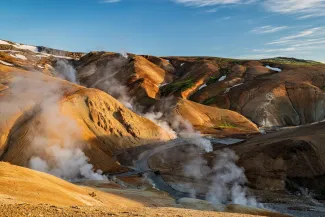Geothermal energy is heat that is extracted from the Earth. A synonym is geothermy, which etymologically comes from the Greek: "geo" (earth) and "thermos" (heat).
For more information, you can find it here.
The system for extracting geothermal energy is quite similar to the principle of central heating: water is used to transport geothermal heat from point A, where it is produced (like a boiler), to point B, where the heat is used at the surface (like a radiator).
In deep geothermal energy with a hydrothermal system, warm water is pumped from deep groundwater layers through one or more boreholes. The heat is extracted, and the cooled water is then pumped back into the groundwater layer at least 1 kilometer away from where it was pumped out. This allows the water enough time to heat up again.
Want to know more? You can find more information here.
Geothermal energy can be used through a district heating network to heat buildings or greenhouses, or for various industrial production processes. The minimum temperature for direct heating applications is 25°C. With hot water – 90°C or higher – electricity can also be generated.
It is a sustainable, price-stable energy source that also offers benefits for the local economy.
No, the use of geothermal energy dates back thousands of years, to the Romans, Greeks, and Scandinavians. In recent decades, it has been reintroduced thanks to technological advancements, for example in Iceland, Sweden, Italy, Turkey, New Zealand, Germany, and the Netherlands.
Even in Belgium, it was used on a small scale: the old swimming pool in Turnhout was heated with geothermal energy starting in 1957. In recent years, the heat pump has also become popular as an alternative energy source for private households.
In theory, yes, but when considering the cost of installation, the location must be taken into account. Certain regions are more suitable for extracting geothermal energy because they have accessible groundwater layers with sufficient permeability. If this is not the case, more expensive techniques must be used. Additionally, there must be enough heat consumers, such as businesses or densely populated areas.
Geothermal energy is a sustainable energy source, but there are some disadvantages and risks associated with it. The first is geological risk: geothermal energy extraction is not possible everywhere, and not at the same cost. It may even happen that, after drilling, it is found that the available groundwater and its temperature are insufficient for sustainable use.
A second risk is the seismicity of the ground; this refers to the movements that take place in the underground. The pressure from pumping water and re-injecting it can cause tremors. These are not felt by humans and are detected by seismometers.
The third risk is preventing different groundwater layers from coming into contact with each other. To avoid this, boreholes have a waterproof casing, and the pressure is closely monitored.
Here you can find more information about the disadvantages and risks of geothermal energy.




